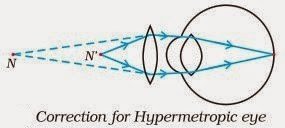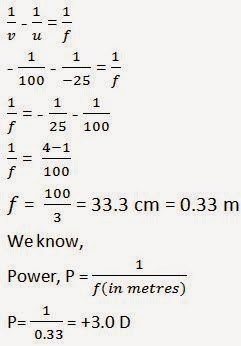Home / NCERT Solution / NCERT Solution for Class 10 / NCERT Solutions for Class 10 Science
CBSE Board NCERT Solutions for Class 10th Science Chapter 11 Human Eye and Colourful World
In Text Questions
Page No: 190
1. What is meant by power of accommodation of the eye?
Answer :
The ability of the eye lens to adjust its focal length, so as to clearly focus rays coming from distant as well a near objects on the retina, is called the power of accommodation of the eye.
2. A person with a myopic eye cannot see objects beyond 1.2 m distinctly. What should be the type of the corrective lens used to restore proper vision?
Answer :
A person with a myopic eye should use a concave lens of focal length 1.2 m so as to restore proper vision.
3. What is the far point and near point of the human eye with normal vision?
Answer :
The near point of the eye is the minimum distance of the object from the eye, which can be seen distinctly without strain. For a normal human eye, this distance is 25 cm.
The far point of the eye is the maximum distance to which the eye can see the objects clearly. The far point of the normal human eye is infinity.
4. A student has difficulty reading the blackboard while sitting in the last row. What could be the defect the child is suffering from? How can it be corrected?
Answer :
The student is suffering from myopia or short-sightedness. The defect can be corrected by the use of concave (diverging ) lens of an appropriate power.
Page No: 197
Excercise
1. The human eye can focus objects at different distances by adjusting the focal length of the eye lens. This is due to
(a) presbyopia
(b) accommodation
(c) near-sightedness
(d) far-sightedness
► (b) accommodation
Page No: 198
2. The human eye forms the image of an object at its
(a) cornea
(b) iris
(c) pupil
(d) retina
► (d) retina
3. The least distance of distinct vision for a young adult with normal vision is about
(a) 25 m
(b) 2.5 cm
(c) 25 cm
(d) 2.5 m
► (c) 25 cm
4. The change in focal length of an eye lens is caused by the action of the
(a) pupil
(b) retina
(c) ciliary muscles
(d) iris
► (c) ciliary muscles
5. A person needs a lens of power -5.5 dioptres for correcting his distant vision. For correcting his near vision he needs a lens of power +1.5 dioptre. What is the focal length of the lens required for correcting (i) distant vision, and (ii) near vision?
Answer :
The power P of a lens of focal length f is given by the relationP= 1/f
(i) Power of the lens used for correcting distant vision = – 5.5 D
Focal length of the required lens, f= 1/Pf= 1/-5.5 = -0.181 m
The focal length of the lens for correcting distant vision is – 0.181 m.
(ii) Power of the lens used for correcting near vision = +1.5 D
Focal length of the required lens, f= 1/P
f= 1/1.5 = +0.667 m
The focal length of the lens for correcting near vision is 0.667 m.
6. The far point of a myopic person is 80 cm in front of the eye. What is the nature and power of the lens required to correct the problem?
Answer :
The person is suffering from an eye defect called myopia. In this defect, the image is formed in front of the retina. Hence, a concave lens is used to correct this defect of vision.
Object distance, u = infinity = ∞
Image distance, v = – 80 cm
Focal length = f
According to the lens formula,
A concave lens of power – 1.25 D is required by the person to correct his defect.
7. Make a diagram to show how hypermetropia is corrected. The near point of a hypermetropic eye is 1 m. What is the power of the lens required to correct this defect? Assume that the near point of the normal eye is 25 cm.
Answer :
A person suffering from hypermetropia can see distinct objects clearly but faces difficulty in seeing nearby objects clearly. It happens because the eye lens focuses the incoming divergent rays beyond the retina. This defect of vision is corrected by using a convex lens. A convex lens of suitable power converges the incoming light in such a way that the image is formed on the retina, as shown in the following figure.
The convex lens actually creates a virtual image of a nearby object (N’ in the figure) at the near point of vision (N) of the person suffering from hypermetropia.
The given person will be able to clearly see the object kept at 25 cm (near point of the normal eye), if the image of the object is formed at his near point, which is given as 1 m.
Object distance, u= – 25 cm
Image distance, v= – 1 m = – 100 m
Focal length, f
Using the lens formula,
A convex lens of power +3.0 D is required to correct the defect.
8. Why is a normal eye not able to see clearly the objects placed closer than 25 cm?
Answer :
A normal eye is unable to clearly see the objects placed closer than 25 cm because the ciliary muscles of eyes are unable to contract beyond a certain limit.
9. What happens to the image distance in the eye when we increase the distance of an object from the eye?
Answer :
The image is formed on the retina even on increasing the distance of an object from the eye. For this
eye lens becomes thinner and its focal length increases as the object is moved away from the eye.
10. Why do stars twinkle?
Answer :
Stars twinkle due to atmospheric refraction of starlight. As the stars are very far away, they behave as almost point sources of light. A son account of atmospheric refraction, the path of rays of light coming from the star goes on varying slightly, the apparent position of the star fluctuates and the amount of starlight entering the eye flickers. So, sometimes, the star appears brighter and at some other time, fainter. Thus, the stars twinkle.
11. Explain why the planets do not twinkle?
Answer :
Planets are much closer to the earth and are seen as extended sources. So, a planet may be considered as a collection of a large number of point-sized light sources. Although light coming from individual point-sized sources flickers but the total amount of light entering our eye from all the individual point-sized sources average out to be constant. Thereby, planets appear equally bright and there is no twinkling of planets.
12. Why does the Sun appear reddish early in the morning?
Answer :
During sunrise, the light rays coming from the Sun have to travel a greater distance in the earth’s atmosphere before reaching our eyes. In this journey, the shorter wavelengths of lights are scattered out and only longer wavelengths are able to reach our eyes. Since blue colour has a shorter wavelength and red colour has a longer wavelength, the red colour is able to reach our eyes after the atmospheric scattering of light. Therefore, the Sun appears reddish early in the morning.
13. Why does the sky appear dark instead of blue to an astronaut?
Answer :
The sky appears dark instead of blue to an astronaut because there is no atmosphere in the outer space that can scatter the sunlight. As the sunlight is not scattered, no scattered light reach the eyes of the astronauts and the sky appears black to them.
EducationIdol are provided study materials for Class 10 Science Chapter 11, NCERT solutions for Class 10 Science Chapter 11 revision notes, NCERT solutions for Class 10 Science Chapter 11 question papers, NCERT solutions for Class 10 Science Chapter 11 sample papers, NCERT solutions for Class 10 Science Chapter 11 syllabus and NCERT solutions for Class 10 Science Chapter 11 important questions. Students can prepare and score well using education idol study materials.